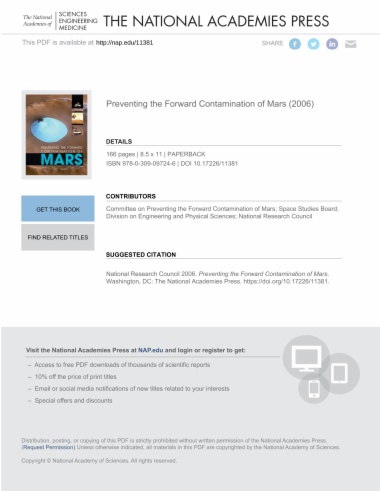Recent spacecraft and robotic probes to Mars have yielded data that are changing our understanding significantly about the possibility of existing or past life on that planet. Coupled with advances in biology and life-detection techniques, these developments place increasing importance on the need to protect Mars from contamination by Earth-borne organisms. To help with this effort, NASA requested that the NRC examine existing planetary protection measures for Mars and recommend changes and further research to improve such measures. This report discusses policies, requirements, and techniques to protect Mars from organisms originating on Earth that could interfere with scientific investigations. It provides recommendations on cleanliness and biological burden levels of Mars-bound spacecraft, methods to reach those levels, and research to reduce uncertainties in preventing forward contamination of Mars.
- Cover
- Front Matter
- Executive Summary
- 1 Introduction
- 2 Policies and Practices in Planetary Protection
- 3 Future Mars Exploration: The Rolling Wave
- 4 Environments on Mars Relative to Life
- 5 Expanding Our Knowledge of the Limits of Life on Earth
- 6 Advances in Technologies for Life Detection and Bioburden Reduction
- 7 Assessing Non-Living Contaminants of Concern
- 8 A Path Forward for Planetary Protection in the 21st Century
- 9 Transition Process and Time Line
- Appendix A Biographical Sketches of Committee Members and Staff
- Appendix B Recommendations from Two Previous NRC Reports on Forward Contamination
- Appendix C Summary of Procedures Currently Used to Assess Bioburden in Spacecraft Assembly Clean Rooms and on Spacecraft
- Appendix D History of Recommended Values for Probability of Growth
- Appendix E Approaches to Bioburden Reduction for Lander Missions to Mars
- Appendix F Ambiguities in Geomorphic Interpretation: Martian Gullies
- Appendix G Spacecraft Propellant and By-Products as Potential Contaminants
- Appendix H Acronyms and Abbreviations

